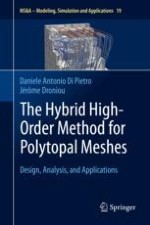This monograph provides an introduction to the design and analysis of Hybrid High-Order methods for diffusive problems, along with a panel of applications to advanced models in computational mechanics. Hybrid High-Order methods are new-generation numerical methods for partial differential equations with features that set them apart from traditional ones. These include: the support of polytopal meshes, including non-star-shaped elements and hanging nodes; the possibility of having arbitrary approximation orders in any space dimension; an enhanced compliance with the physics; and a reduced computational cost thanks to compact stencil and static condensation.
The first part of the monograph lays the foundations of the method, considering linear scalar second-order models, including scalar diffusion – possibly heterogeneous and anisotropic – and diffusion-advection-reaction. The second part addresses applications to more complex models from the engineering sciences: non-linear Leray-Lions problems, elasticity, and incompressible fluid flows. This book is primarily intended for graduate students and researchers in applied mathematics and numerical analysis, who will find here valuable analysis tools of general scope.
